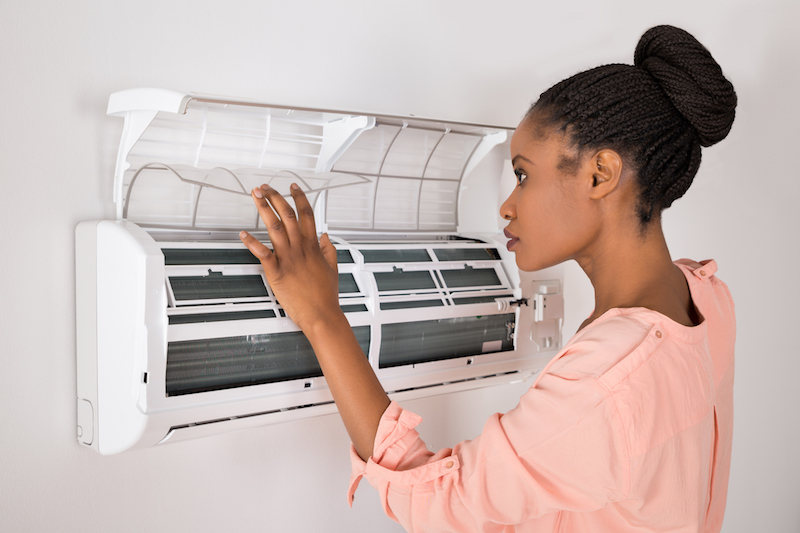
You shouldn’t be forced to compromise on comfort or spend a lot to keep your house at a pleasant temp during summer weather.
But what is the ideal temp, exactly? We discuss recommendations from energy specialists so you can determine the best setting for your residence.
Here’s what we recommend for the most energy-efficient setting for air conditioning in Beckley.
Recommended Thermostat Settings for Summer
Most households find placing the thermostat at 72-73 degrees provides ideal comfort. However, if there’s a big difference between your indoor and outside warmth, your AC costs will be greater.
These are our suggestions based on the U.S. Department of Energy (DOE) and ENERGY STAR®.
While at home: 78 degrees. While that appears hot, there are approaches you can keep your home pleasant without having the AC going constantly.
Keeping windows and curtains shut during the day keeps cool air where it needs to be—within your home. Some window treatments, including honeycomb shades or plantation shutters, are made to deliver added insulation and better energy savings.
If you have ceiling fans in your house, the DOE says you can move thermostat temperatures about 4 degrees warmer without sacrificing comfort. That’s because they freshen through a windchill effect. Because they cool people, not areas, switch them off when you leave a room.
If 78 degrees still seems too warm at first glance, try running a trial for approximately a week. Begin by increasing your setting to 78 degrees while you’re at your house. Then, steadily turn it down while using the tips above. You may be amazed at how refreshed you feel at a warmer temperature setting.
While away: 88 degrees. There’s no rationale for keeping the air conditioning working all day while your house is vacant. Moving the setting 7–10 degrees warmer can save you as much as 5–15% on your AC expenses, according to the DOE.
When you come home, don’t be tempted to put your thermostat below 78 to cool your house more quickly. This isn’t useful and typically leads to a higher cooling expense.
A programmable thermostat is a helpful way to keep your settings controlled, but you have to set programs. If you don’t set programs, you might forget to move the set temperature when you leave.
If you need a hassle-free solution, think over getting a smart thermostat. This thermostat links with your phone, so it realizes when you’re at your residence and when you’re away. Then it instinctively changes temperature settings for the biggest savings. How much exactly? Usually $180 yearly on heating and cooling, according to ENERGY STAR.
Another perk of using a smart thermostat? You can use your phone to keep an eye on and adjust temperature settings from just about anywhere.
While sleeping: Around 70 degrees. While ENERGY STAR suggests 82 degrees, that could be unpleasant for most families. Many people sleep better when their sleeping area is cold, so that’s why the National Sleep Foundation advises 60–67 degrees. But that might be too cool, due to your clothing and blanket preference.
We suggest using a similar test over a week, setting your temp higher and gradually turning it down to determine the right setting for your residence. On cool nights, you could learn keeping windows open at night and using a ceiling fan is a superior solution than using the air conditioner.
More Approaches to Conserve Energy During Hot Weather
There are additional methods you can save money on cooling bills throughout warm weather.
- Install an energy-efficient air conditioning system. Central air conditioners only work for about 12–15 years and lose efficiency as they become older. An upgraded air conditioner can keep your house more comfortable while keeping cooling bills down.
- Schedule annual air conditioner maintenance. Regular air conditioner maintenance keeps your system running properly and could help it operate at greater efficiency. It can also help prolong its life expectancy, since it allows professionals to spot seemingly insignificant issues before they create a major meltdown.
- Switch air filters frequently. Read manufacturer instructions for switching your air filter. A clogged filter can result in your system short cycling, or switch on and off too frequently, and increase your energy.
- Measure attic insulation levels. Nearly 90% of residences in the United States don’t have proper insulation, according to the Insulation Institute. Many southern climates need 13–14” of attic insulation, while northern climates need 16–18”.
- Have your ductwork checked. Ductwork that has come apart over time can leak conditioned air into your attic, walls or crawl space. This can result in big comfort issues in your house, including hot and cold spots.
- Seal cracks, doors and windows. Keep warm air where it should be by closing cracks. You can also caulk or weather strip doors to trap more cold air inside.
Save More Energy This Summer with Appalachian Heating
If you are looking to conserve more energy during warm weather, our Appalachian Heating professionals can provide assistance. Get in touch with us at 304-877-5566 or contact us online for extra information about our energy-saving cooling options.



